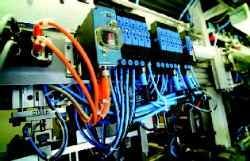Whose Fault Is It?
Electronic module allows automovite manufacturer to better understand faults and greatly reduce troubleshooting times.
If a fault exists, the DDL system identifies exactly which component has failed and displays a message to operators.
Swedish manufacturer MPE supplies machinery for the automotive industry. Last year, they supplied the first machine with the Drive & Diagnostic Link (DDL) from Bosch Rexroth to Finnveden Powertrain AB. This machine assembles valve lifters for fuel injection systems of Scania's new truck. The machine is complex, with over 120 pneumatic cylinders and grippers.
Efficient diagnostics were important to minimize troubleshooting times in the event of a breakdown. With Profibus DP fieldbus and DDL technology, operators receive a fault message in text form and can quickly deal with any fault.
The machine assembles the components that make up the valve lifters in the fuel injection system. The valve lifter maintains contact with the camshaft, controlling the fuel injection into one of the engine cylinders.
The precision required is very high. "We left zero tolerance behind long ago," Bengt-Olof Nilsson remarks with a smile. He runs MPE together with his brother, Lars-Erik.
Temperature extremes
The shaft is bonded to the hub by shrink fitting, which means that the two components are at different temperatures when assembled. The shaft is cooled to 194° C with liquid nitrogen, while the hub is induction heated to 182° C. The temperature difference allows the shaft to be inserted without the risk of scratches. Once the temperatures have equalized, the two parts grip each other as firmly as if they had been cast in one piece. Besides this shrink-fitting operation, the valve lifter passes through 14 other stations, where everything from ball seats to rivets are mounted in place. Various lifter functions are tested at almost every station.
"As well as being an assembly machine, it carries out a final quality check," explains Nilsson. "If any of the lifter's functions isn't up to scratch, it is rejected automatically."
A detailed history of the assembly of each individual lifter can also be displayed — from the pressure used to press down a ball seat or rivet to whether or not the wheel rotates correctly on the shaft.
"To be able to guarantee deliveries, we need a highly reliable manufacturing process," continues Nilsson. "Any stoppages must be short ones. The ability to output fault messages as text obviously makes work easier for our machinery operators. If anything goes wrong, we need be able to identify the problem right away."
For more information, email [email protected]


